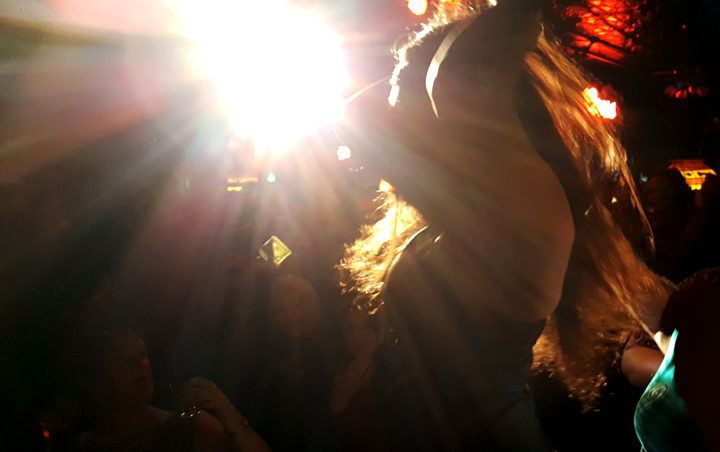Drag shows in Juneau have become a major, annual fundraiser for the nonprofit Alaskan AIDS Assistance Association.
Attendance topped 200 after two nights of Femme Fatale shows in Juneau on Sept. 30 and Oct. 1.
At the Rendezvous bar in downtown Juneau, a few people are sipping drinks and early birds are trickling in.
The drag queens and kings aren’t set to take the stage for another hour and a half.
But backstage — a bar store room — it’s cramped.
Makeup palettes, shoes, clothes and mannequin heads with colorful wigs litter the tables.
Five queens and seven kings, each over-the-top representations from either side of the gender spectrum, do their makeup in front of mirrors.
Stephanie Davis’ hair is dyed blue and she has it pulled back into a bun.
And she’s a little nervous.
“Yep, that’s kind of an understatement,” Davis said. “I’m kinda just trying to put on, like, my beard and without shaking too much and making squiggly lines, which I guess would be kind of more organic, but yeah, a little nervous.”
She’s turning into her drag king persona, Stevie Smalls, an extremely confident frat boy.
“I’m kind of like a insecure, shy person, so I chose something completely opposite of that to do,” she said.
The transformation from Stephanie Davis to Stevie Smalls takes patience and practice. Her eyes switch intently between small handheld and large vanity mirrors.
With makeup, Davis stipples on a beard, like the kind teen-heartthrobs grow without shaving for a few days.
Stevie’s beard takes just a few minutes.
It’s a fraction of the preparation the king needs before taking the stage.
“Um, you have to like bind and stuff, just flatten down your chest area and try not to make yourself look too hippy, because I’m naturally super hippy and boys are not often super hippy so I’m trying to straighten it out,” Davis said.
To help mask curves, drag kings use multiple sports bras, Ace bandages and kinesiology tape — the kind athletes use to ease muscle pain.
This is Davis’ first solo performance, though it is her second as a drag king.
“It was really fun. I did the boy band – we were the four D’s – We did One Direction and Backstreet Boys – and you really can’t go wrong with either of those,” she said. “It was fun to choreograph and stuff. But this is a little bit different, because you can’t choreograph too much stuff alone because it just looks weird. Know what I mean? But yeah, it was a lot of fun the first time. And I’m still with Ryder here, so it’s not, not too bad.”
She’s referring to Ryder Strong, another drag king portrayed by Cate Ross.
At a crowded makeup table, Ross, Davis and another king take turns applying highlights and lowlights, using a technique called contouring.
Chiseled jawlines and wider noses emerge from their soft, feminine facial features.
“I’m terrible at contouring, but I want to try and look like a boy, so I’m actually trying my hardest to ‘Oh let me try to make my face less soft, and let me try and flatten my chest as much as possible,’” she said. “So it’s no pain, no gain, but it’s fun to try and make that silhouette look right even though I haven’t mastered it yet.”
Later, it’s Stevie who comes through the curtain and lip-syncs to Zayn’s “TiO (or Take It Off).”
Stevie gyrates with a steamy, masculine charisma while making eyes with the women at the show.
His beard moves as he mouths the words: “I just wanna watch you when you take it off.”
Stevie works the crowd, pausing to dance with some audience members.
“With that attitude, making those scrunchy, smooshy faces and like kind of being super into myself? I have to go above and beyond with the confidence thing because I have zero, so if I’m just way too confident, I think that that’s why I chose that persona,” Davis said.
Each king or queen embodies different personality types and looks. There’s high fashion with glitz and glamour, to flamboyant camp through extravagant makeup and props.
Davis partially credits the rise of drag to reality TV.
“I think that drag in general just got more accepted, and I think that that whole ‘RuPaul’s Drag Race’ thing had really big play in it,” Davis said.
She says the mainstreaming of LGBTQ culture has helped, too.
“Not all drag people are queer, but that whole lifestyle has become more accepted so I think that more and more things are getting accepted,” Davis said. “More drag queens are all over TV and everything like that.”
Davis originally wanted to perform in bio-femme drag, in which female participants perform as drag queens. But bio-femme drag isn’t as recognized as other forms, so Davis works instead toward performing as a drag king.
Between tickets and tips to the performers, the organizers estimate the two-day event raised more than $10,000 for the Alaskan AIDS Assistance Association.


